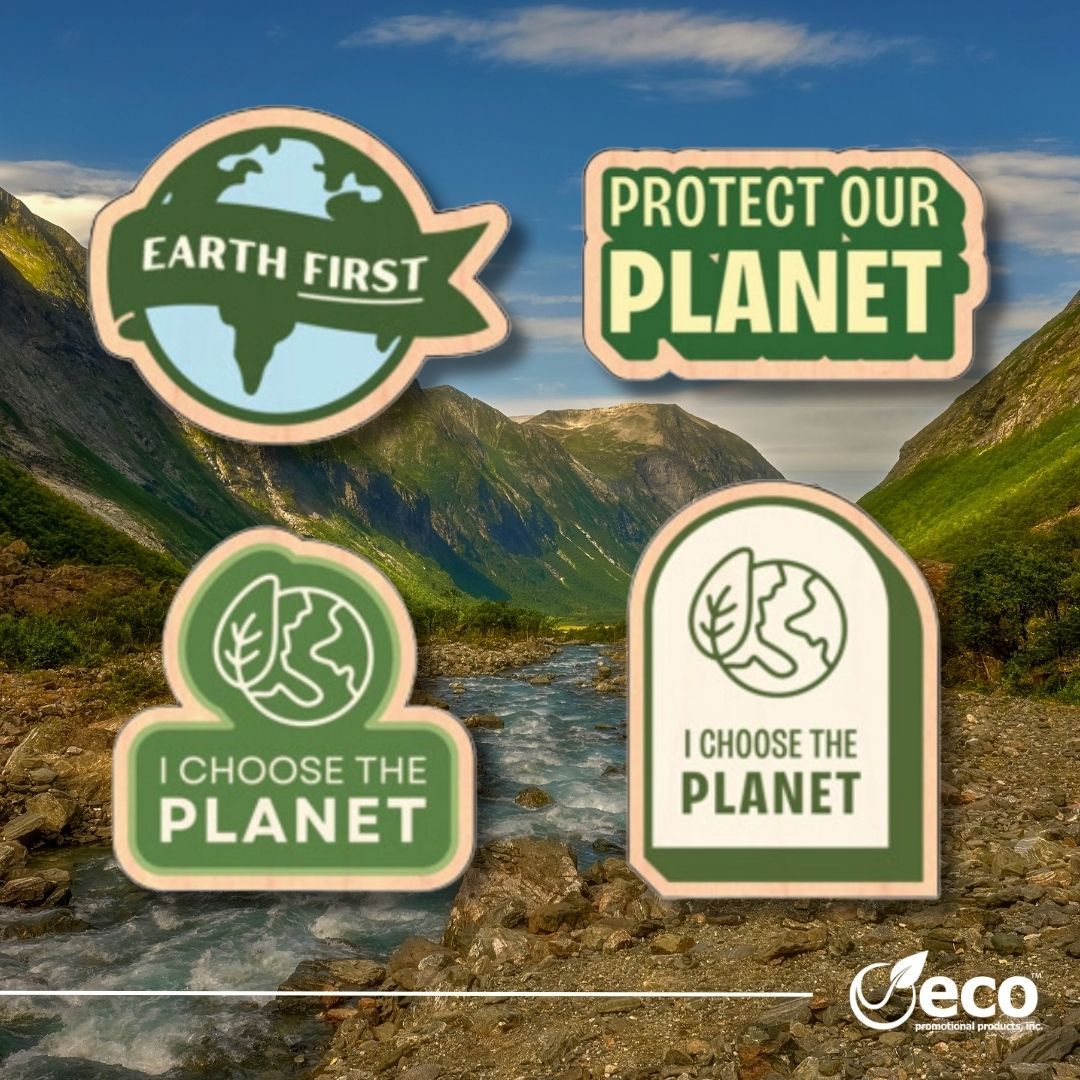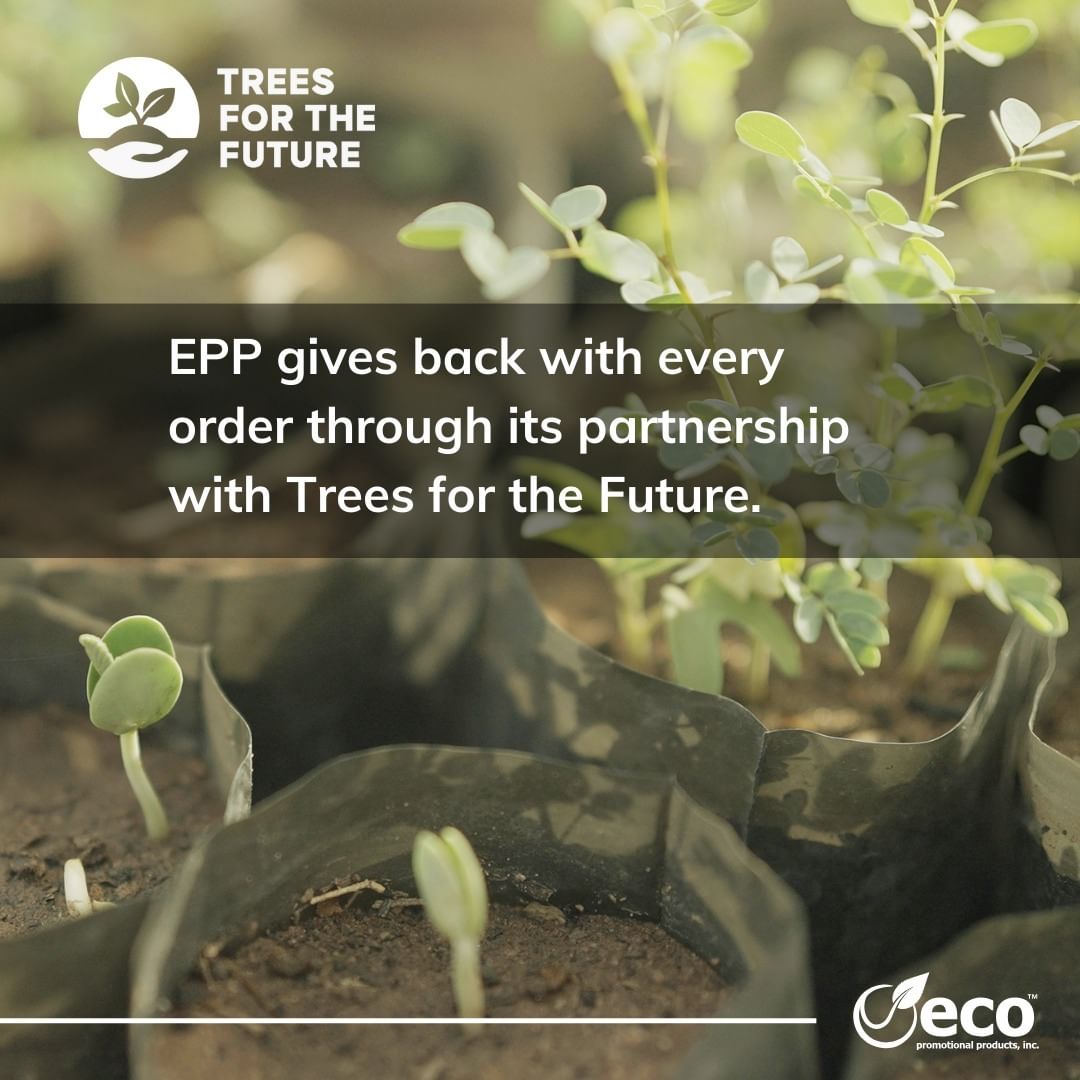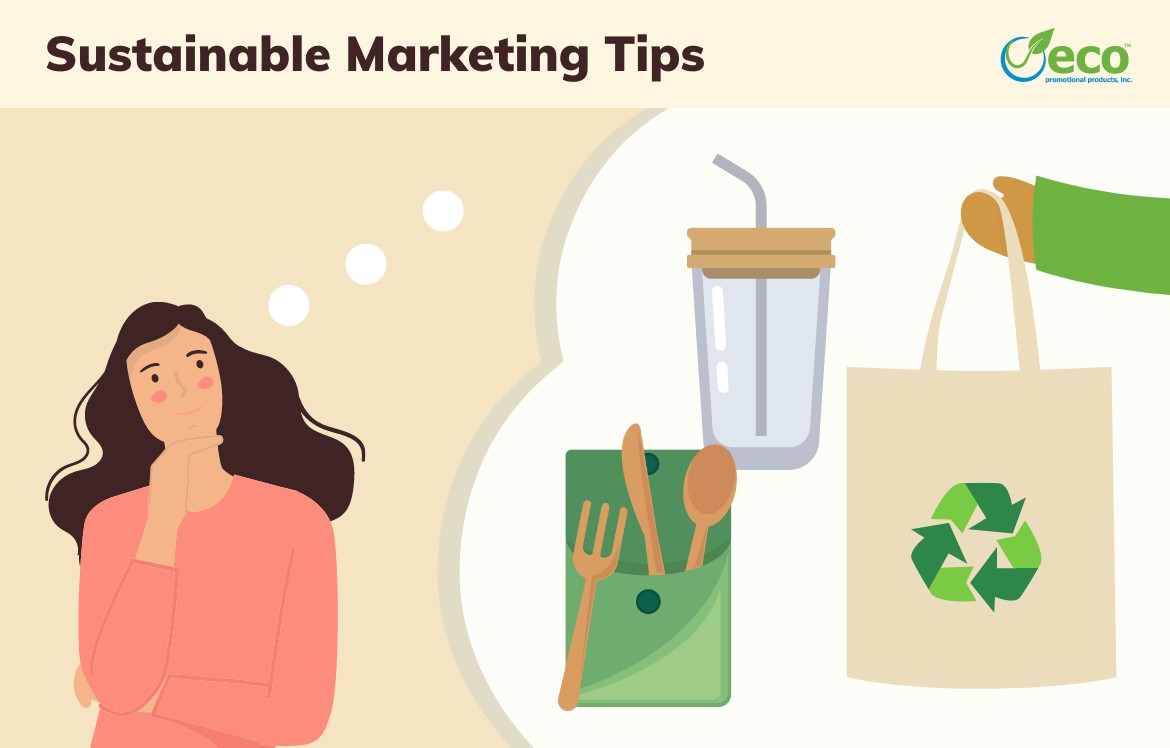How to Master Sustainable Marketing Techniques for 2024
As you seek to master the latest promotional marketing techniques, sustainability, and ethical marketing practices should be front and center of your strategy.
Sustainable marketing and promotional marketing strategies are good for the planet and great for brands. In a world where 64% of consumers report “high levels of concern” about sustainability, it pays to integrate environmental, social, and governance (ESG) principles to resonate with conscientious consumers and stakeholders.
For example, using eco-swag like customizable, logoed products made from sustainably sourced natural, biodegradable, recycled, or reusable materials in promotional marketing campaigns can significantly boost brand image.
Efforts like these help businesses remain competitive and relevant in an increasingly eco-conscious world. Embracing sustainability is not just a trend; it's a strategic imperative that drives growth, enhances employee satisfaction, and fosters community engagement, ultimately leading to greater financial stability and success.
In this guide, we’ll explore the following steps involved in promotional marketing:
- The Basics of Promotional Marketing: We’ll explain what promotional marketing is and how sustainability factors into it.
- Identifying Your Target Audience: Next, we’ll explore the importance of knowing your customers and aligning your mission to the things people actually care about.
- Developing a Sustainable Promotional Strategy: We’ll then guide you through the process of creating a successful sustainable promotional strategy.
- Creating a Promotional Mix: We’ll explain how to effectively communicate to your target audience and get them to care about your brand.
- Evaluating the Effectiveness of the Promotional Strategy: We’ll show you how to analyze the results of your promotional methods and make necessary adjustments to improve their effectiveness.
- Staying Updated with Promotional Marketing Trends: Finally, we’ll stress the importance of staying updated with the latest trends and developments in promotional marketing.
By the end of this guide, you’ll have a clear understanding of how to leverage promotional marketing techniques to drive more brand awareness and customer engagement while also appealing to the growing number of consumers who prioritize eco-friendly and socially responsible practices.
You will be equipped to create impactful, sustainable promotional marketing strategies that not only boost your brand's success but also contribute to a better, more sustainable future.
The Basics of Promotional Marketing
You learn in business school that a promotional marketing campaign is a series of coordinated marketing activities designed to achieve specific business goals, such as increasing brand awareness, generating leads, boosting sales, or launching a new product.
However, that doesn't prepare you for the rapidly changing market dynamics, such as those driven by climate change. While the goal remains the same—generating customer interest and growing revenues—the methods to achieve these objectives have evolved significantly.
Today, successful promotional marketing campaigns must captivate and engage their audience and align with growing consumer demand for sustainability and corporate social responsibility.
A shift to sustainable promotional marketing not only helps attract eco-conscious consumers but also builds a loyal customer base that values and supports responsible business practices.
Adapting to these changes means staying ahead of market trends, continuously innovating, and being transparent about your sustainability efforts. It’s about creating meaningful connections with your audience by showing that your brand stands for more than just profit—it stands for a better, more sustainable future for all.
Examples of Promotional Marketing
Promotional marketing encompasses a variety of strategies and tools designed to capture attention, drive engagement, and boost sales. Effective campaigns leverage multiple channels to reach their target audience, creating a cohesive and compelling brand experience.
Here are some key examples of promotional marketing techniques that businesses can use to achieve their goals.
Advertising
Advertising is all about getting your message out there. This can include billboards, TV commercials, social media ads, a selection of branded merchandise, or even sponsored posts on blogs.
The key is to make the content engaging and relevant to your target audience, ensuring it captures attention and drives interest in your products or services. In this case, using customizable, branded, and logoed eco-swag can give your brand a boost by showcasing your commitment to sustainability.
Sales Promotions
Sales promotions are short-term tactics designed to boost sales. These can include discounts, buy-one-get-one-free offers, limited-time deals, and flash sales. They create a sense of urgency that encourages customers to act quickly, driving immediate sales and increasing customer acquisition.
Offering eco-friendly and sustainably made products as part of your promotional marketing appeals to eco-minded consumers and shows your commitment to helping the planet.
Public Relations
Public relations is all about managing your brand’s reputation and relationship with the public. The goal is to create a positive brand image in consumers’s minds through channels such as press releases, charity events, influencer partnerships, and strategic social media marketing.
Customized promotional products, such as eco-friendly swag, are great tools for PR because they reinforce your brand’s commitment to sustainability and community engagement.
However, you shouldn’t claim that your promotional materials are biodegradable, eco-friendly, or sustainable just because the manufacturer says they are—you must be able to certify all these claims independently or with third parties.
At Eco Promotional Products, Inc., we vouch for all our sustainable promotional materials. We source each product ethically to ensure all our promotional marketing products are vetted safe and eco-friendly materials claims are confirmed. From our BPA-free water bottles and recycled plastic items to our biodegradable, reusable shopping bags, our products meet the highest sustainability standards.
Direct Marketing
Direct promotional marketing takes a more personal approach, such as contacting customers directly through emails, text messages, or mailers.
Direct marketing focuses on building strong customer relationships, making them feel valued and understood. Personalization and targeted messaging are crucial to the success of direct marketing efforts, ensuring each communication resonates with the recipient.
This is a powerful promotional marketing channel if you use it effectively. For example, demonstrate your dedication to sustainability by using digital channels only. Where print materials are necessary, use recycled paper, soy-based inks, recycled or compostable packaging, etc.
But the real game-changer is the rise of data analytics. Brands can now use data to understand their customers better, tailor their promotional strategies, and measure performance in real time. It’s a brave new world, and it’s full of opportunities for those willing to embrace it.
Define the Target Audience for Promotional Marketing Campaigns
As we navigate the digital landscape of 2024, the ability to precisely identify and connect with your audience for promotional marketing is more crucial than ever.
Knowing who your customers are, their preferences, and their behaviors allows you to tailor your marketing efforts effectively, ensuring that your message resonates and drives engagement.
By focusing on both existing and potential new customers, you can create personalized experiences that foster loyalty and attract new business, setting the stage for long-term success.
Demographics and Psychographics
Start by gathering demographic information about your audience, such as age, gender, location, and income level. This data provides a basic understanding of who your audience is and can help segment your market into more manageable groups.
If you need deeper insight, get into psychographics—your audience’s interests, values, attitudes, and lifestyle choices. This will give you a more holistic view of your audience and enable you to create more targeted and effective promotional strategies.
The most common ways of understanding audience demographics are:
- Analytics Tools: Leverage tools like Google Analytics, social media insights, and customer relationship management (CRM) software to collect and analyze demographic data.
- Surveys and Feedback: Conduct surveys and solicit feedback through email campaigns, social media, or your website to gather psychographic information directly from your audience.
- Segmentation: Segment your audience based on both demographics and psychographics to create detailed customer profiles. This allows you to tailor your messaging to specific groups more effectively.
- Social Listening: Monitor social media platforms to understand what your audience is talking about, their interests, and their sentiments towards certain topics. This can provide valuable psychographic insights.
- Persona Development: Develop detailed buyer personas that combine demographic and psychographic information. These personas help visualize your target audience and guide your marketing strategies.
- Behavior Analysis: Analyze customer behavior on your website and social media channels. Look at metrics such as time spent on pages, click-through rates, and conversion paths to understand what resonates with your audience.
- A/B Testing: Use A/B testing to determine which messages, images, and offers perform best with different segments of your audience. This helps refine your approach based on real data.
Competitor Analysis
Look at who your competitors are targeting. While you shouldn’t copy their strategies blindly, understanding their target audience can provide insights into potential market segments you may have overlooked.
Customer Feedback
Listen to what your existing and new customers are saying. Reviews, comments, and direct feedback can provide invaluable insights into what your audience values and expects from your brand.
By thoroughly understanding your target audience through demographic and psychographic analysis and observing your competitors, you can tailor your promotional strategies to effectively engage and resonate with your customers.
For example, incorporating sustainable practices into your marketing efforts will appeal to eco-minded consumers, enhancing your brand's reputation and fostering long-lasting relationships with like-minded individuals.
| Fact: Did you know that the Gen Z generation is known as “the guardians of sustainability”? For them, the quality and sustainability of a product have a major impact on purchase decisions, and they don’t mind paying more for eco-friendly products |
How to Develop an Eco-Friendly Promotional Strategy

Developing an eco-friendly promotional marketing strategy involves integrating sustainable practices at every stage of your marketing efforts. This approach not only helps reduce your environmental footprint but also appeals to a growing segment of eco-minded consumers.
This step-by-step guide will help you create an effective and sustainable promotional strategy.
1. Conduct a Sustainability Audit
Start by assessing your current marketing practices to identify areas where you can reduce waste and improve sustainability.
- Assess energy consumption in your marketing operations.
- Evaluate the environmental impact of your promotional materials.
- Identify opportunities to use recycled or eco-friendly materials.
- Review supplier practices for sustainability.
2. Set Clear, Achievable Goals
Define specific, measurable goals for your eco-friendly promotional strategy. Examples of goals include:
- Reduce carbon footprint by 20% in the next year.
- Use 100% recycled materials for all printed promotional materials.
- Increase the use of digital marketing to reduce paper waste.
3. Choose Sustainable Promotional Products
Select products that are eco-friendly, ethically made, and appeal to your target audience. For example, you can use sustainability criteria such as:
- Made from certified recycled or biodegradable materials.
- Refillable, purposeful, and long-lasting.
- Certified organic, PVC-free, BPA-free, and FDA-compliant.
For instance, you can choose branded merchandise made from recycled cotton, use compostable or biodegradable packaging, and offer promotional items like refillable water bottles and reusable shopping bags.
4. Integrate Sustainability into Your Messaging
Ensure that your marketing messages highlight your commitment to sustainability.
- Emphasize the eco-friendly benefits of your products.
- Highlight your company’s efforts to reduce environmental impact.
- Use terms like “sustainably made,” “eco-friendly,” and “environmentally responsible.”
An impactful promotional marketing campaign includes examples of what you’ve already done to make your business more sustainable.
It could be showcasing your use of recycled materials in products, highlighting your switch to eco-friendly packaging, sharing your efforts to reduce energy and water consumption, or promoting your partnerships with like-minded, environmentally responsible organizations.
For example, an insurance company could highlight paperless policy options and investments in renewable energy. This helps to inspire and engage your audience to support your brand on an emotional level.
5. Leverage Digital Marketing
Minimize the use of physical materials by maximizing digital channels. These include:
- Email campaigns; use recycled paper alternatives for any physical touchpoints.
- Social media campaigns focused on sustainability initiatives.
- Virtual events and webinars to reduce the need for travel and printed materials.

6. Partner with Like-Minded Organizations
Collaborate with organizations that share your commitment to sustainability. For example, Eco Promotional Products, Inc., is a B-Corp certified company that also collaborates with Trees for the Future, contributing to the Forest Garden Approach to combat deforestation and support biodiversity.
For every invoiced order, on behalf of our customer we donate a tree seedling to this initiative which aims to plant one billion trees by 2030. We also offer steep discounts and sponsorships to communities in need and support various charitable causes.
This naturally enhances credibility and brand reputation, creating access to new audiences who value sustainability. It also generates opportunities for co-branded eco-friendly initiatives, which could potentially reach a wider audience.
7. Monitor and Report Progress
Track the effectiveness of your eco-friendly promotional strategy and make adjustments as needed.
This is done through Key Performance Indicators (KPIs), such as a reduction in carbon footprint, an increase in the use of sustainable materials, or customer feedback on eco-friendly practices.
To generate performance reports, use reports from:
- Sustainability reports for stakeholders.
- Regular updates on social media and your website.
- Customer surveys to gather feedback and improve practices.
8. Educate and Engage Your Audience
Inform your audience about your sustainability efforts and encourage them to participate. For example, start by creating educational content on your website and social media. Make it part of a larger content marketing campaign designed to increase awareness and online sales.
You can also create interactive campaigns that involve customers in sustainability initiatives and create more opportunities for customer engagement.
If you can, go the extra mile and organize community events focused on environmental responsibility.
| Did You Know? QR codes on promotional products have seen a resurgence in popularity. By embedding a QR code that leads to an exclusive offer or a landing page on a promotional item, businesses can track the effectiveness of their campaigns in real-time and engage existing customers uniquely and interactively. |
Create a Promotional Marketing Mix With Sustainability
Creating a promotional marketing mix involves selecting the right combination of marketing tools to effectively reach your target audience and achieve your business goals. These will depend on your goals, whether it’s to increase sales or boost brand awareness.
A well-crafted promotional mix ensures that your message is consistently communicated across various channels, enhancing brand recognition and driving engagement. Here’s how to develop an effective promotional mix:
- Advertising: this is paid, non-personal communication aimed at a broad audience
- Use channels such as traditional media (TV, radio) and digital channels (social media, Google ads, etc), and highlight sustainable products and practices.
- Sales promotions: Short-term incentives to encourage immediate purchases.
- Examples include seasonal sales and clearances
- Use public relations to manage the public perception of your brand.
- For example, organize charity events and community outreach
- Hold press releases and media interviews
- Direct marketing, which targets individuals with directed communication
- Use it to drive promotional offers and get subscriptions to a newsletter.
- Make it worth their while with valuable tips and information about sustainability and other important industry topics
- Leverage personal selling, with in-store product demonstrations, consultations, and B2B sales at events and trade shows
- Make sure to provide eco-friendly product samples, promotional swag, and other promotional items
It’s especially important to ensure that events and experiences are sustainably managed. This includes organizing trade shows, exhibitions, and interactive installations with a view to minimizing environmental impact.
Implement zero-waste policies, opt for carbon-neutral options, and use eco-friendly materials for event setups. Other additions to your marketing mix may include content marketing, reward programs for existing customers, and other promotional marketing efforts.
| Fun Fact: Did you know that the first promotional products in the United States were commemorative buttons dating back to 1789 when George Washington was elected president? These buttons helped showcase the power of promotional items from the beginning of the nation's history. |
How Effective is a Sustainable Promotional Strategy?
A sustainable marketing promotion strategy can significantly enhance brand reputation, customer loyalty, and long-term financial success. Various data points and industry studies support the effectiveness of these strategies.
In particular, consumer attitudes towards sustainability reveal strong support for eco-friendly marketing promotion practices.
- 66% of consumers are willing to pay more for sustainable products
- 81% of consumers consider sustainability in their purchasing decisions
- 72% of consumers reporting increased trust in brands that adopt sustainable practices
These statistics barely scratch the surface, but they underscore the growing consumer demand for sustainable and socially responsible business practices.
Companies adopting eco-friendly strategies often see better brand loyalty and a willingness to pay among their audience. These insights highlight the crucial role sustainability plays in meeting consumer expectations and achieving long-term business success in today’s market.
Stay on Top of Promotional Marketing Trends

Having been in the business of sourcing and supplying sustainable promotional products for almost two decades, the team here at Eco Promotional Products, Inc., has first-hand experience on how consumer preferences have evolved.
People now scrutinize what materials are used in their items. They care deeply about the presence of BPA in their water bottles, the use of recycled plastics, and whether the packaging is biodegradable.
More than ever, terms like certified recycled, sustainable, reusable, waste-free, biodegradable, eco-friendly, environmental, environmentally responsible, are becoming critical in any marketing campaign. They can help you increase sales and build a powerful brand following because it shows them you stand for something they care about.
This shift underscores the importance of integrating sustainability into promotional strategies, as eco-conscious consumers increasingly demand environmentally responsible products, even when they're free giveaways.
Adopt Eco-Friendly Innovations
Sustainability remains a top priority, with innovations continually emerging in eco-friendly materials and practices. Stay updated with the latest developments, such as biodegradable packaging, reusable materials, and energy-efficient production methods.
Highlight these innovations in your promotional campaigns to attract eco-conscious consumers and set your brand apart as a leader in sustainability.
Prioritize Sustainability
More and more consumers are prioritizing sustainability in their purchasing decisions. Promoting your brand’s sustainability efforts can boost your brand image and attract a more conscious and loyal customer base.
For example, consider using promotional products made in the USA, crafted with recyclable or renewable materials, and other ethically sourced advantages. These are powerful, tangible representations of your organization’s dedication to a healthier future.
Leverage Influencer Marketing
Influencer marketing remains a powerful tool, especially when focusing on sustainability. Collaborating with influencers who advocate for eco-friendly practices and resonate with your target audience can significantly enhance your brand's visibility and credibility.
In 2024, consider partnering with micro-influencers who have a smaller but highly engaged following. Their authentic connection with their audience can effectively promote your brand's commitment to sustainability, showcasing eco-friendly products and practices in a genuine and relatable manner.
Embrace Personalization and Customization
Consumers increasingly expect personalized experiences. Integrating customization options into your promotional products, such as personalized names or unique designs, can enhance customer engagement. This approach not only increases the perceived value of the items but also strengthens customer loyalty by making them feel valued and understood.
Summary
The key to mastering promotional marketing in 2024 and beyond is to stay flexible and adaptable. Embrace new trends, experiment with innovative strategies, and continuously learn and evolve.
Sustainable promotional marketing is not just a current trend but an investment in the future. By integrating eco-friendly practices into your promotional strategies, you build a strong foundation for long-term success, enhancing your brand's reputation and meeting the growing consumer demand for environmental responsibility.
Eco Promotional Products, Inc. is a valuable partner for businesses looking to embrace sustainability while growing their brand visibility and revenue through eco-friendly promotional materials
By providing a wide range of sustainably sourced and ethically produced products, we help you align your marketing efforts with your environmental values, ensuring a positive impact on both your brand and the planet.
Check out some of our eco-friendly promotional products to find out what works best for you.



